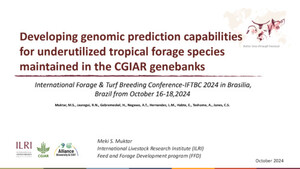
Effects on animal performance and sward composition of mixed and sequential grazing of permanent pasture by cattle and sheep
Abstract
revious experiments have shown that mixed or conjoint grazing, when two or more animal species are grazed together, can lead to improved performance of one or more of the species and a higher total output per unit area. Sequential grazing systems, when different animal species graze an area in succession, also have the potential to improve productivity. This experiment directly compared these two approaches for integrating the grazing of cattle and sheep when pastured on improved permanent pasture. Four treatments were compared: 1) sheep only from May to October (S/S); 2) cattle only from May to July followed by sheep only from August to October (C/S); 3) cattle and sheep from May to July, sheep only for the rest of the growing season (C + S/S); and 4) cattle and sheep from May to October (C + S/C + S). Each treatment was replicated three times. From May until weaning at the end of July the plots were grazed by steers and ewes and lambs, and from weaning until October by steers and lambs. Sward heights were maintained at 6 cm using a “put and take” stocking system. Animal performance and sward composition data were collected during three growing seasons, 2001–2003. During the pre-weaning period lambs grazing plots which were grazed only by sheep had significantly poorer growth rates than those grazing plots where there was mixed grazing. Lambs grazing the sheep only plots also had lower liveweight gain during the post-weaning period, with the highest growth rates being recorded on the C + S/C + S treatment. Carrying capacity and total liveweight gain per unit area post-weaning were also consistently higher for the C + S/C + S treatment, while carrying capacity pre-weaning was highest for the C/S treatment. Measurements of clover content in the grazed horizon and botanical separation of material from quadrat cuts indicated that even under relatively controlled conditions choice of grazing system can influence sward composition. However, there was no clear link between any single sward change and the growth of the animals, indicating that the improved performance of cattle and sheep under mixed grazing is the result of a combination of factors, rather than a response to a particular sward parameter.
Citation
Fraser, M.D., Davies, D.A., Vale, J.E., Hirst, W.M. and Wright, I.A. 2007. Effects on animal performance and sward composition of mixed and sequential grazing of permanent pasture by cattle and sheep. Livestock Science, 110(3):251-266









